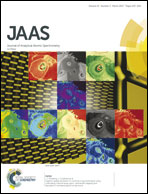In situ207Pb/206Pb isotope ratio measurements using two Daly detectors equipped on an ICP-mass spectrometer
Abstract
The simultaneous detection of 206Pb and 207Pb ions has been made by multiple-ion counting ICP-mass spectrometry using two Daly detectors (MC-ICPMS). To evaluate the long-term gain stability of the detectors, 135Ba/138Ba and 136Ba/138Ba ratios have been measured by a combination of Daly and Faraday detectors (135Ba(D)/138Ba(F)) and an electron multiplier and Faraday detectors (136Ba(EM)/138Ba(F)). The measured 136Ba(EM)/138Ba(F) ratio changed 2% through the 10-hour analysis, whereas the 135Ba(D)/138Ba(F) showed smaller changes (<0.5%) over the 10-hour period, demonstrating that the Daly detector could provide better gain stability against conventional electron multipliers. After the correction for the counting loss due to dead time, the Daly detector is capable of accepting signal intensities as high as 107 cps. This indicates that the overlap of the analysis range, between the Daly detector (100 to 107 cps) and the Faraday detector (104 to 1010 cps), would be at least two orders of magnitude, suggestive of easier cross calibration of the collector gain between the detectors. With the present two Daly detectors, in situ207Pb/206Pb ratio measurements have been made on the Nancy 91500 zircon standard through the sample introduction technique using laser ablation. The overall analytical precision and the relative deviation from the literature values were 5.1% and 0.04%, respectively. The data obtained here clearly demonstrate that the LA-MC-ICPMS technique equipped with the Daly detectors would become a major analytical tool for in situ U–Pb geochronology.



 Please wait while we load your content...
Please wait while we load your content...